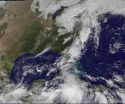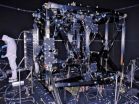(Press-News.org) NASA's Aqua satellite has peered into the cloud tops of System 96L in the western Caribbean early this morning and noticed that they've become colder and higher, which indicated the storms was strengthening and organizing. Just over eight hours later, the new Tropical Depression 16 was born, and now has the potential to become a tropical storm before it merges with an elongated area of low pressure near the Florida late on Wednesday.
Tropical Depression 16 was officially named this morning, Sept. 28 at 11 a.m. EDT by NOAA's National Hurricane Center in Miami, Fla. Many watches and warnings have also already been posted this morning. At 11 a.m. Tropical Depression 16's center was about 180 miles south of Havana, Cuba and 390 miles south-southwest of Miami, Fla. near 20.6 North latitude and 82.5 West longitude. It is moving north-northeast near 10 mph and had maximum sustained winds near 35 mph. Its minimum central pressure was 1001 millibars.
The government of the Cayman Islands has issued a Tropical Storm Warning for all of the Cayman Islands. The government of Cuba has issued s Tropical Storm Warning for the Cuban provinces from Mantanzas eastward to Ciego De Avila. The government of the Bahamas has issued a tropical storm warning for the Northwestern and Central Bahamas. This Warning Includes the Abacos, Andros Island, Berry Islands, Bimini, Eleuthera, Grand Bahama Island, New Providence, Cat Island, the Exumas, Long Island, Rum Cay, and San Salvador.
In the U.S., Florida is under a Tropical Storm Warning and Watch. A Tropical Storm Warning has been issued for the Florida coast from Jupiter Inlet southward to East Cape Sable, and for all of the Florida Keys, including Florida Bay and the Dry Tortugas. A Tropical Storm Watch has been issued for the west coast of Florida from north of east Cape Sable to Chokoloskee and for the east coast of Florida from north of Jupiter Inlet to Sebastian Inlet.
The Atmospheric Infrared Sounder instrument, known as AIRS has the ability to determine cloud top and sea surface temperatures from its position in space aboard NASA's Aqua satellite. Cloud top temperatures help forecasters know if a storm is strengthening or weakening. When cloud top temperatures get colder it means that they're getting higher into the atmosphere which means the "uplift" of warm, moist air is stronger and it will form stronger thunderstorms (that power a tropical cyclone). When cloud-top temperatures warm up it means that the cloud tops are lower than they were before, indicating that the storm is weakening.
When the Aqua satellite passed over Tropical Depression 16 (TD16) from space on Sept. 28 at 0635 UTC (2:35 a.m. EDT) the AIRS instrument took the temperature of the cloud tops in the storm and found them to be as cold as or colder than -63 Fahrenheit throughout a very large area within TD16, indicating the storm had a good amount of energy to power it up. The area of strong thunderstorms in the AIRS images is quite large, and TD16 is already raining on western Cuba.
The Geostationary Operational Environmental Satellite known as GOES-13 flew over Tropical Depression 16 on Sept. 28 at 1425 UTC (10:25 a.m. EDT) as it strengthening into a depression. GOES-13's visible imagery showed a large extent of cloud cover, spanning over Cuba and Jamaica, the Cayman Islands and northeastward into south Florida.
The National Hurricane Center (NHC) in Miami, Fla. noted this morning, Sept. 28 at 8 a.m. EDT that TD16 is going to bring some heavy rains and squally conditions in the Caribbean. NHC said, "Heavy rains and strong gusty winds to tropical storm force are expected to affect the Cayman Islands, Jamaica and Cuba today. These weather conditions are likely to spread over the Florida Keys, southern Florida and the northwestern Bahamas later today and Wednesday."
During the morning hours of Sept. 28, the strongest winds were happening about a couple of hundred miles east and south of the Isle of Youth, Cuba and Grand Cayman. If TD16 strengthens into a tropical storm, it would be named Nicole.
South-southwesterly vertical wind shear associated with a large upper-level trough moving into the southeastern U.S. is expected to limit the storm's intensification, although it is near tropical storm-force this morning. The projected track of the TD16 takes it in a north-northeasterly direction across Cuba toward southeastern Florida.
Meanwhile, there's another female named storm that's still making waves in the Atlantic Ocean basin, Julia. However, Julia is just a remnant low pressure area and is about 150 miles south-southeast of Bermuda. This remnant low is moving west-northwest near 15 mph and is not in a good environment for redevelopment. The NHC gives Julia's remnants a meager ten percent chance of redeveloping in the next 48 hours, so TD16 is the one to watch.
INFORMATION:
NASA sees colder cloud-top temps in new Tropical Depression 16, warnings up
2010-09-29
ELSE PRESS RELEASES FROM THIS DATE:
Goddard team obtains the 'unobtainium' for NASA's next space observatory
2010-09-29
Imagine building a car chassis without a blueprint or even a list of recommended construction materials.
In a sense, that's precisely what a team of engineers at the NASA Goddard Space Flight Center in Greenbelt, Md., did when they designed a one-of-a-kind structure that is one of 9 key new technology systems of the Integrated Science Instrument Module (ISIM). Just as a chassis supports the engine and other components in a car, the ISIM will hold four highly sensitive instruments, electronics, and other shared instrument systems flying on the James Webb Space Telescope, ...
NASA's Webb Telescope unique structural 'heart' passes extreme tests
2010-09-29
GREENBELT, Md. -- NASA engineers have created a unique engineering marvel called the ISIM structure that recently survived exposure to extreme cryogenic temperatures, proving that the structure will remain stable when exposed to the harsh environment of space. The material that comprises the structure, as well as the bonding techniques used to join its roughly 900 structural components, were all created from scratch.
The ISIM, or the Integrated Science Instrument Module Flight Structure, will serve as the structural "heart" of the James Webb Space Telescope. The ISIM ...
Employee wellness plans should include entire company, not just sick workers
2010-09-29
ANN ARBOR, Mich.---A study of employees at a west Michigan hospital showed some of the most unhealthy workers that University of Michigan researchers had ever seen.
But in four years, the workplace wellness plan at Allegiance Health in Jackson, Mich. had fueled some of the biggest improvements in employee health that those same researchers had ever witnessed.
The researchers were studying the hospital system to evaluate the health risk changes in employees in the four years after Allegiance implemented a workplace wellness program. The "It's Your Life" program was ...
Tiny generators turn waste heat into power
2010-09-29
Washington, D.C. (September 28, 2010) -- The second law of thermodynamics is a big hit with the beret-wearing college crowd because of its implicit existential crunch. The tendency of a closed systems to become increasingly disordered if no energy is added or removed is a popular, if not depressing, "things fall apart" sort-of-law that would seem to confirm the adolescent experience.
Now a joint team of Ukrainian and American scientists has demanded more work and less poetry from the second law of thermodynamics, proposing a novel "pyroelectric" method to power tiny ...
New device for identifying aggressive breast cancers
2010-09-29
Washington, D.C. (September 28, 2010) -- A new disposable device based on advances in microfluidics may help identify advanced breast cancer patients who are candidates for therapy with the drug trastuzumab (Herceptin). The device is described in the American Institute of Physics' journal Biomicrofluidics.
Aggressive breast cancers with poor prognosis typically have abnormal levels of the protein HER2 (the tyrosine kinase human epidermal growth factor receptor 2). The new elastomeric, rubber-like device is designed to efficiently capture cancer cells overexpressing HER2 ...
Finding a buckyball in photovoltaic cell
2010-09-29
Washington, D.C. (September 28, 2010) -- Polymer-based photovoltaic cells have some real advantages compared to the currently used semiconductor-based cells. They are easy to make and the materials are cheap. The challenge is to figure out how to make efficient cells while keeping the manufacturing cost low.
One approach uses a light-absorbing polymer along with a derivative of a sixty-carbon fullerene molecule, commonly known as a buckyball. For maximum efficiency, the two materials must be present in thin layers near opposite electrodes but most analytical methods ...
UH Manoa professor finds Muslim women who wear headscarves face workplace discrimination in the US
2010-09-29
Professor Sonia Ghumman from the University of Hawai'i at Mānoa Shidler College of Business has completed an intensive marketing research on the effects of Muslim women who wear hijabs (head scarves) in the U.S.
Ghumman's research examined the expectations that women who wear hijabs have regarding their employment opportunities. "We surveyed 219 American Muslim women on their job seeking experience," said Ghumman. "The findings reveal that Hijabis are not only aware of their stigma of being Muslim, but also expect to be treated differently in the workplace as a result ...
New VARI findings next step to growing drought-resistant plants
2010-09-29
Grand Rapids, Mich. (September 28, 2010) – New findings from Van Andel Research Institute (VARI) scientists could lead to environmentally-friendly sprays that help plants survive drought and other stresses in harsh environments to combat global food shortages. The study is a follow-up to findings published in Nature last year that were named among the top breakthroughs of 2009 by Science magazine.
"I think that the work established the methodologies and feasibilities of finding cheap and environmentally benign chemicals for agricultural application to improve the water ...
Climate accord loopholes could spell 4.2-degree rise in temperature and end of coral reefs by 2100
2010-09-29
A global temperature increase of up to 4.2 º C and the end of coral reefs could become reality by 2100 if national targets are not revised in the Copenhagen Accord, the international pledge which was agreed at last year's Copenhagen's COP15 climate change conference.
Just ahead of the next United Nations Climate Change Conference, which starts on 4 October in Tianjin, China, a new report published today, Wednesday, 29 September, in IOP Publishing's Environmental Research Letters describes how, due to lack of global action to date, only a small chance remains for keeping ...
Father's incarceration associated with elevated risks of marijuana and other illegal drug use
2010-09-29
In a recently published study in the journal Addiction, researchers from Bowling Green State University report evidence of an association between father's incarceration and substantially elevated risks for illegal drug use in adolescence and early adulthood.
The number of persons incarcerated in the United States has sharply risen over the past several decades, from about 250,000 in 1975 to 2,250,000 in 2006. So too has the number of children with incarcerated parents, particularly fathers. The consequences of father's incarceration for their children, families, and communities ...

